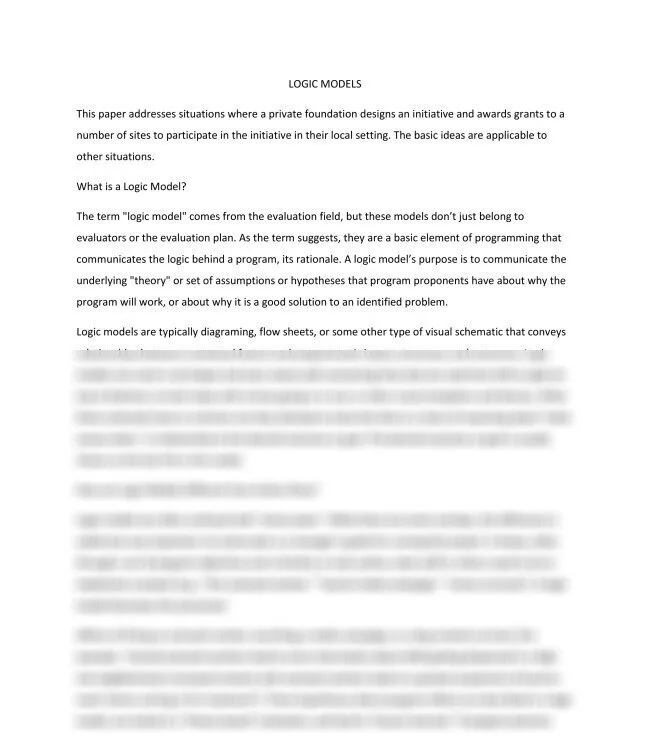LOGIC MODELS
LOGIC MODELS
"If "The "action "cause "hire "if-then" "launch "lessons "links "logic "mental "protective "red "revise "the "theory" "theory-based" "trained "what ("risk (For (although (and (called (e.g., (or . A AIDS Action An And As Based Be Be? Because Can Conveyed? Detailed Developing Different During Else Faulty Goals Good How However, Ideally If It It’s Logic MODELS Model? Models Models? On On? Once One Other Plans? Program Should The Their These They This Thus Two What When While Who Why a about abstract accompanied accompany achieved action actions actions/causes addresses addressing addressing, administrators, affecting all allowed also an analytic. and answer any applicable are argue argument arise arrows art as assumptions at attempt awards background based basic basis be because become been beginning begins behind beliefs believed belong between board both bottom); boxes boxes, bulleted but by campaign, campaign," can cannot cannot. causal causes certain chain changed? circular clear clearly clients come comes coming common communicate communicated communicates complexly conceptualization concurrently confused congruent connecting consists contacts contained contextual convert convey conveys credibility, critical crucial curricula"). curricula. decrease deep defined defined, defining depending depict described description. designs desired detail detail, detailed determine develop developed, developers, developing development devices. diagraming, diagrammed difference difficult dispensed divided do does don’t drawn during e.g., each easily effect" effects efficacious. either element embedded end endeavor enough entity especially essential essential). ethic evaluation evaluation, evaluators evaluators, every everyone example, exist expected experience experience, explained explains explicitly expresses expressing expression factors factors" factors"). fairly few field field, fields) fill fit five flag" flow follow. follows, for for." force—money, form forms formulating formulation foundation foundation) foundation. foundation’s four from full fundamental future gained generic gets getting given goal goal. goals goals) going good grant. grantees grants greater guide guiding hand, happen hard hard-to-reach has have headings help high-risk hiring how however, however—or hypotheses ideas identified if illustrates implement important important. in include increase increased influence influences influencing informants, information initial initiating initiation initiative initiative. initiatives initiative—the initiative’s inputs, into involve involved is is. it its it’s just key knowledge knowledge—in language largely last launching lead leaders leading leads learned." learning learning. left less life likely lines link links literature, local logic looking loops loses low, major manager’s many map materials. may media members mental metaphors missing model model" model, model. model; model? modeling models models. models: models? model’s more move much narrative need needed needed. needs negative neighborhood; new not number objectives occur of often on once one ongoing or organization organizations, organization’s other others out out; outcome outcomes. outline, outreach overlaps, own ownership page page. paper part/phase participants participate participating parties parts passionate people, people. periodically. personal persuasive, phase phases philosopher philosophy phrases, plan plan. planned planners planners’ plans." point points. positive possible. potential practice! preliminary presumed private probably problem problem" problem, problem," problem. problem." problems process, processes, professional program program, program. programmatic programming program’s project project. projections, proponents proportion purpose question rationale rationale, rationale. read reasoning reasoning" reference relationship relationships remembered, remembered. reporting represent requires research result results revised revised, revision revisions right role running said, same schemata schematic science second see seeds seeking separate serve set setting. shapes sheets, short should show shown shows shows, signals significant single site-specific sites sites, situations situations. six sizes: so solution some sources. specific staff staff, stated statements statements, statements. statements—without step strategically strategies strategy. stripped subtle succeed. success successful. such suggests suggests, supply support task term tested than that the their them, then theory there therefore these they thing this thought three through time timeline times to together top transition treatment"). trouble. two twoLOGIC type typically unabashedly underlying understand understanding understood understood. unrelated useful useful. using usually value value. variables vary very visual visual, visually way we well we’re what what," when where whether which whole. why will with within words work work, work. worker, worker," workers would written you •
LOGIC MODELS
This paper addresses situations where a private foundation designs an initiative and awards grants to a number of sites to participate in the initiative in their local setting. The basic ideas are applicable to other situations.
What is a Logic Model?
The term "logic model" comes from the evaluation field, but these models don’t just belong to evaluators or the evaluation plan. As the term suggests, they are a basic element of programming that communicates the logic behind a program, its rationale. A logic model’s purpose is to communicate the underlying "theory" or set of assumptions or hypotheses that program proponents have about why the program will work, or about why it is a good solution to an identified problem.
Logic models are typically diagraming, flow sheets, or some other type of visual schematic that conveys relationships between contextual factors and programmatic inputs, processes, and outcomes. Logic models can come in all shapes and sizes: boxes with connecting lines that are read from left to right (or top to bottom); circular loops with arrows going in or out; or other visual metaphors and devices. What these schemata have in common are they attempt to show the links in a chain of reasoning about "what causes what," in relationship to the desired outcome or goal. The desired outcome or goal is usually shown as the last link in the model.
